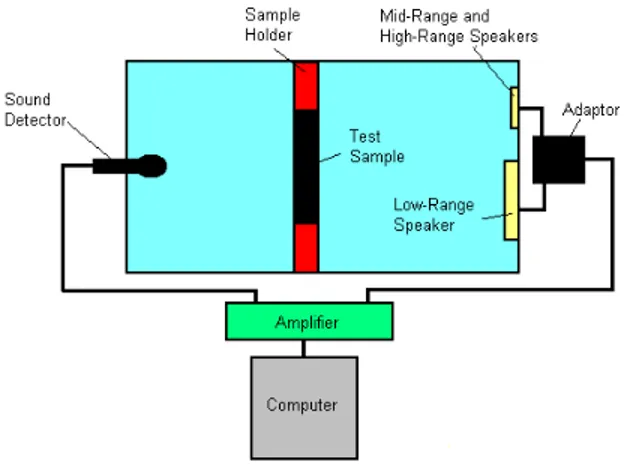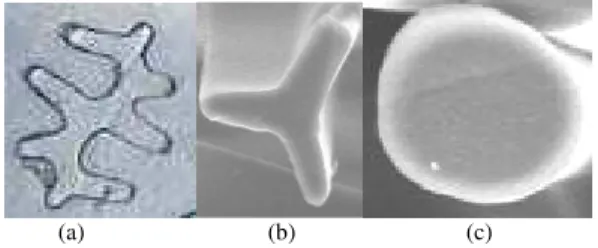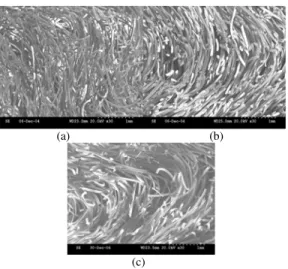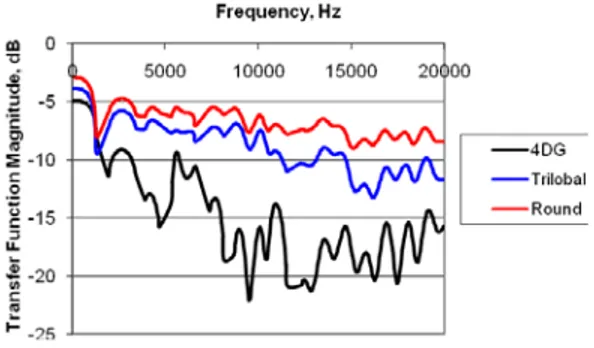Effects of Fiber Den ier, Fiber Cross-Section al Shape an d
Fabric Den sity on Acoustical Behavior of Vertically
Lapped Non woven Fabrics
Mevlut Tascan, Ph.D., Edward A. Vaughn, Ph.D.
Clemson University, Clemson, South Carolina, USA
Correspondence to:
Mevlut Tascan email: mevlutt@clemson.edu
ABSTRACT
Acoustical insulation and absorption properties of nonwoven fabrics depend on fiber geometry and fiber arrangement within the fabric structure. The different structures of the fibers result in different total surface areas of nonwoven fabrics. Nonwoven fabrics such as vertically lapped fabrics are ideal materials for use as acoustical insulation products, because they have high total surface. Vertically lapped nonwoven technology consists of carding, perpendicular layering of the carded webs, and through-air bonding using synthetic binder fibers. The surface area of the fabric is directly related to the denier and cross-sectional shape of the fibers in the fabric. Smaller deniers yield more fibers per unit weight of the material, higher total fiber surface area, and greater possibilities for a sound wave to interact with the fibers in the fabric structure.
The research in the literature uses two methods for measuring acoustical properties of fabric materials: the impedance tube and reverberation room method. Small test samples are in the impedance tube method and sound absorption coefficient is determined at each frequency. Large reverberation rooms and large test samples are used for the reverberation room method. A direct comparative acoustical properties measurement device that was designed and fabricated at Clemson University School of Materials Science & Engineering was used to measure acoustical insulation in this research. This paper provides a description of the measurement devices and acoustical measurement data for vertically lapped nonwoven fabrics made from three different polyester fiber shape and two denier levels.
INTRODUCTION
Insulation and absorption properties of nonwoven fabrics depend on fiber geometry and fiber arrangement within the fabric structure. Because of their complex structure, it is very difficult to define
the microstructure of nonwovens. The structure of nonwovens only has fibers and voids that are filled by air. The different structures of the fibers result in different total surface areas of nonwoven fabrics.
Nonwoven fabrics such as vertically lapped are ideal materials for use as acoustical insulation products, because they have high total surface. Vertically lapped nonwoven fabric technology consists of carding, vertical layering of the carded webs, and through-air bonding using synthetic fibers. The surface area of the fabric is directly related to the denier and cross-sectional shape of the fibers in the fabric. Smaller deniers yield more fibers per unit weight of the material, higher total fiber surface area, and greater possibilities for a sound wave to interact with the fibers in the structure.
A number of numerical and experimental methods relevant to sound absorption behavior of textiles have been reported [1-7] in the literature. The methods that are shown in the literature are mainly based on the energy dissipation behavior of sound waves while they travel through the media. Shoshani and Yakubov [1] report that in order to increase the absorption coefficient, textile material should be designed such that porosity will increase along the propagation direction of the sound wave, and porosity should be at its maximum value in the middle of the material. Ballagh [2] shows the relationship between the fiber properties such as density, fiber diameter, and acoustic properties. The results were used to predict the acoustical properties of wool fiber. Voronina [3] determined the sound absorption coefficient of a fibrous material layer by acoustic parameters such as the dimensionless characteristic impedance and propagation constants.
Small test samples are used in the impedance tube method and sound absorption coefficients are determined at each frequency. Large reverberation rooms and large test samples are used for the reverberation room method. A direct comparative acoustical properties measurement device that was designed and fabricated at Clemson University School of Materials Science & Engineering was used in this research to measure acoustical insulation.
EXPERIMENTAL MATERIALS AND METHODS
Sound Measurement Apparatus
The sound insulation measurement apparatus developed at Clemson and termed the “Clemson-Boston Differential Sound Insulation tester” [8]. As shown in Figure 1, this device consists of six components: the sound signal-processing computer, the sound signal amplifier, the sound source, the sound chamber, the sound detector, and the material sample holder. The white noise with the sound frequencies ranging from 73Hz to 30,000Hz is used for the sound insulation measurements.
FIGURE 1. Illustration of the Clemson–Boston Differential Sound Insulation Tester (1) computer, (2) amplifier, (3) sound source, (4) sound chamber, (5) sample holder, and (6) sound detector.
The signal-processing computer generates the sound signals. The signals are amplified by the signal amplifier. The amplified signals are sent to the sound source to be converted to sound waves. The material to be tested is mounted in on sample holder, placed in the sound path. The sound wave is transmitted inside the sound chamber passing through the sample material to the sound detector. The sound detector converts the received sound signals to electrical signals and sends back to the signal-processing
computer to be analyzed. If no sample is in the path of the sound wave, a background reference is obtained and sample data can be compared to this air reference. If two samples are compared, data from one sample is compared to the other with no changes to the settings of the instrument.
Data from the sound measurement apparatus were taken as transfer function magnitude (dB). By definition, the dB is 10 times the common logarithm of the ratio of two powers, as expressed in equation 1.
⎟⎟ ⎠ ⎞ ⎜⎜ ⎝ ⎛ =
2 P
1 P log 10 dB
N (1)
where NdB is the number of decibel, P1 is the power
of the generated signal from the source, and P2 is
power of the transmitted/reflected signal from the microphones.
It can be seen that a 6dB change in power gives 4 times the loudness and 2 times the voltage or current of a sound signal.
This sound spectrometer is not an ideal sound chamber with perfect acoustical properties, but it provides a comparison of the samples under the same conditions and therefore yields a direct acoustical comparison.
It should be noted that the reproducibility of the apparatus can be verified by the fact that when, after initial calibration and Fourier Transformation, subsequent tests are made with no specimen in the sample holder, no transfer function magnitude data are generated – i.e. the plotted results are identical to the base line.
Fiber Materials and Processes
Five different vertically lapped nonwoven fabrics were used with three different fiber shapes and two different fiber deniers. They were compressed at a temperature of 180°C in a Carver motorized molding apparatus. The compression-molded samples were trimmed to appropriate sample dimension for the Sound Insulation Tester, namely 30.5cm by 30.5cm (12in by 12in).
vertically lapped nonwoven fabrics. 4DG, trilobal, and round fiber photos are shown in Figure 2.
(a) (b) (c)
FIGURE 2. (a) 4DG, (b) trilobal, and (c) round fiber cross-sections.
4DG fiber has deep groves and channels along its longitudinal axis. These grooves provide higher fiber surface area [9]. 4DG fiber has an octalobal cross sectional shape. The properties of matrix fibers and binder fiber that were used to make nonwoven fabrics are shown in Table I.
TABLE I
MATRIX AND BINDER FIBERS USED TO PRODUCE VERTICALLY LAPPED NONWOVEN FABRICS FOR SOUND
INSULATION MEASUREMENTS
Sample ID *
Fiber Denier
Fiber Type
Fiber Cross-Section
Fiber Length
1 3 FIT 401-4111 4DG 1.5"
2 3 Fortrel 282 Round 2"
3 15 FIT 1310 4DG 2"
4 15 FIT 1309 Trilobal 2"
5 15 Martin Colorfi Round 2"
Binder
fiber 4
Hoechst Cellbond
Bi-Co PET Round 2”
(*) 1–5 denotes the sample ID for the matrix fibers that were used to produce vertically lapped nonwoven fabrics.
Vertical lapping (Struto) technology was developed at the Technical University of Liberec, Czech Republic. In this technology, fibers are processed into vertically lapped highloft nonwovens. Struto technology consists of carding, vertical layering of the carded webs, and thermal bonding using [10]. The fabric samples listed in Table II were produced by Struto International Inc. Kings Mountain, NC [11]. Vertically lapped nonwoven fabric can also be produced by the Santex Wavemaker by Santex-Group International AG [12].
A very simple layout of a struto (vertical lapping) line is shown in Figure 3. A carding machine processes a properly mixed blend of matrix and binder fibers (1). The carded web is formed into a vertically lapped web using a vibration Lapper (2) to
form a fiber batt on the conveyor belt of the through air thermal bonding Chamber (3). After passing through the chamber the vertically lapped fabric is cooled and wound up (4). In addition a supporting layer (5) can be brought from below onto the conveyor belt of the bonding chamber to produce two-layer nonwoven fabric [10].
Weight, thickness, and total surface area data for vertically lapped fabrics are given in Table II. Fiber perimeters were measured with Scalex Plan Wheel XLU [13] by using the SEM pictures of the fabrics for the total surface area calculation. Three different fiber samples for the same fiber were measured and each fiber was measured three times and final average value was taken as fiber perimeter. The surface areas of the fibers are calculated by multiplying the perimeter and the total fiber length in the fabric. The surface areas of 30.5cm x 30.5cm nonwoven fabrics are shown in Table II.
TABLE II
VERTICALLY LAPPED FABRIC PROPERTIES USED FOR SOUND INSULATION MEASUREMENTS
Sample ID *
Fabric Weight (g/m²)
Fabric Thickness
(cm)
Total Fiber surface area
(m²/g)
1A 1807 1.0 72.6
1B 1933 0.4 77.7
1C 1900 0.2 76.3
1D 2013 0.2 80.9
1E 2022 0.1 81.2
2A 1989 1.0 29.6
2B 2019 0.4 30
2C 1817 0.2 27
2D 1694 0.2 25.2
3A 1911 1.1 35.5
3B 1800 0.4 33.5
3C 1689 0.2 31.4
3D 1678 0.2 31.2
3E 1903 0.1 35.4
4A 1956 1.0 21.7
4B 1656 0.4 18.4
4C 1844 0.3 20.5
4D 1748 0.2 19.4
5A 1719 1.0 11.4
5B 1822 0.4 12.1
5C 1611 0.3 10.7
5D 1444 0.2 9.6
(*) 1–5 denotes the sample ID as shown in Table I; A–E represent the sample densities A= 0.07g/cm3, B=0.16g/cm3, C=0.28g/cm3,
FIGURE 3. A simple layout of struto line [11] and the position of fibers after carding and struto processes.
Fabric air permeability is very important parameter for thermal and acoustical insulation of nonwoven fabrics. Higher air permeability results in higher sound transmission, therefore less sound insulation. Air permeability was measured using FX3300 Textech Air Permeability Tester [14].
The vertically lapped fabrics were compressed and thermally molded to comparable thicknesses and densities on a Carver press using 12.7mm (0.5in), 6.4mm (0.25in), and 3.2mm (125in) frames. The minimum thickness was achieved by compressing the fabrics without a frame at a pressure of 30 tons.
After the samples were compressed, they were cut into 30.5cm by 30.5cm (12in by 12in) test specimens. From the sample population, fabrics with two comparable structural parameters were selected for a comparative analysis. SEM pictures of vertically lapped nonwoven fabrics made from 15 denier round, 4DG, and trilobal polyester fibers are shown in
Figure 4.
(a) (b)
(c)
FIGURE 4. SEM photos of three vertically lapped nonwoven fabric made from (a) round, (b) 4DG, and (c) trilobal fibers.
RESULTS AND DISCUSSION
The acoustical insulation behavior comparison among the vertically lapped nonwoven fabrics made from three different shaped and two different denier fibers was used to study the effect of the fiber denier, fiber cross-sectional shape, and fabric density on fabric acoustical insulation.
Data from the test device are appropriate for obtaining the acoustical insulation information, because the sound spectrometer measures sound transmission, and fewer transmitted sound waves equate to better acoustical insulation. The results are given in the form of plots between the frequency (Hz) and the transfer function magnitude (dB). Following a Fourier Transformation, the data from the test without the test sample serves as the base line or zero point on the x-axis. Data from each test material are plotted as negatively increasing sound frequency values. If the transmitted sound difference is not more than 1dB, the difference is not significant, because of the accuracy of the device and the range of human hearing. The sound spectrometer used in this experiment has the capability of measuring frequencies between 0Hz and 30,000Hz. Because the frequency range of human hearing is between 0Hz and 20,000Hz, this zone was selected as the test frequency range.
Fabric Air Permeability
Fabric air permeability is very important parameter for thermal and acoustical insulation of nonwoven fabrics. Higher air permeability results in higher sound transmission, therefore less sound insulation.
As shown in Figure 5, vertical lapped fabrics made from 4DG fiber has less air permeability data at all fabric densities and deniers than vertical lapped fabrics made from round fibers. Air permeability difference of vertical fabric made from different fiber cross-section depends on the total surface area in fabric.
Effect of Fiber Denier
The acoustical insulation comparison among the nonwoven fabrics made from 3den round, 3den 4DG, 15den round, and 15den 4DG polyester fibers were used to study the effect of the fiber denier on fabric acoustical insulation.
FIGURE 6. Transmitted sound results for vertically lapped nonwoven fabrics made from 3 and 15 denier fibers with 0.07g/cm3 fabric density.
As shown in Figure 6, vertically lapped test materials made from 3den round fibers are better sound insulators than test materials made from 15den round polyester fibers. For all frequencies between 73Hz and 20,000Hz, vertically lapped fabrics made from 3 denier round polyester fibers insulate the sound approximately 5dB more than vertically lapped fabric made from 15 denier round polyester fibers. The 5dB difference indicates that vertically lapped fabric made from 3 denier round polyester fiber insulates the sound 3.16 times more than the vertically lapped fabric made from 15 denier round polyester fiber. The reason for this result may be because smaller deniers yield more fibers per unit weight of the material, higher total fiber surface area, and greater possibilities for a sound wave to interact with the fibers in the structure.
The difference in transmitted sound between test materials made from 3den round polyester fibers and 15den round polyester fibers does not change with density of the fabric. Sound insulation of nonwoven test material made from 3 denier round fibers is much
better than the sound insulation of nonwoven test material made from 15den round fibers.
Effect of Fiber Shape
The acoustical insulation comparison for the vertically lapped nonwoven test materials made from 15den round, trilobal, and 4DG shaped fibers with comparable thicknesses and densities was used to study the effect of expanded surface area. Expanded surface area results from trilobal and 4DG fiber shapes.
FIGURE 7. Transmitted sound results for vertically lapped fabrics made from 15 denier 4DG, trilobal, and round fibers with 0.43g/cm3 density.
As shown in Figure 7, the vertically lapped fabrics made from 4DG and trilobal fibers have better sound insulation characteristics than nonwoven fabrics made from round fibers. For the frequencies between 4500Hz and 5000Hz, the difference in sound insulation data between the vertically lapped fabric made from 15 denier 4DG fiber and fabric made from 15 denier round fiber reaches 8dB, which shows that vertically lapped fabric made from 15 denier 4DG polyester fiber insulates the sound 6.3 times more than the fabric made from 15 denier round polyester fiber at those given frequencies. The reason for this result may be because of the effect of surface area in the fabric. As shown in Table IV, 4DG fibers have approximately three times more surface area than round fibers. Higher surface area in a nonwoven fabric increases the possibility of the sound wave interaction with the fibers and results in more effective sound deadening in the nonwoven fabric.
Effect of Fabric Density
As shown in Figure 8, vertically lapped fabric at higher density insulated the sound more than the fabric at lower density. At the frequencies between 4000Hz and 5000Hz, the difference in insulation data between vertically lapped fabric at 0.43g/cm3 fabric density and the fabric at 0.07g/cm3 fabric density reaches 13dB, which shows that vertically lapped fabric at 0.43g/cm3 fabric density insulates the sound 20 times more than fabric at 0.07g/cm3 fabric density.
FIGURE 8. Transmitted sound results for vertically lapped fabrics
made from 15 denier 4DG fibers with various volumetric densities.
The reason for this result may be because increasing the density of the fabric results in smaller voids between the fibers and smaller voids result in higher possibility for the sound wave to interact with the fibers. Another reason is that higher density at the fabric surface results in more reflection of the sound wave than transmission. Therefore, fewer sound waves will get in the fabric and fewer sound waves will be detected by the microphone of the sound measurement apparatus.
At a fabric density level of approximately 1.15g/cm3, fibers are mostly crushed, and the material is no longer a nonwoven fabric; it is more like a polyester plastic sheet film. The surface is very smooth on a plastic; and therefore, most of the sound wave is reflected instead of moving into the material. This property results in transmitted sound values that are much lower for the polyester plastic than for nonwoven fabrics. Increasing sound reflection rather than increasing sound absorption is not an effective way to insulate the sound, because environmental noise pollution with increasing reflection values of the sound wave will result.
As indicated in Figure 8, vertically lapped fabrics with higher densities yielded better sound insulation properties than nonwoven fabrics at lower densities.
Therefore, we conclude that fabric density affects the sound insulation property of the nonwoven fabrics positively.
SUMMARY AND CONCLUSIONS
The effects of fiber denier, fiber shape, and fabric density on compression molded, vertically lapped fabrics were investigated. Fabrics made from 3 denier fibers were better sound insulators than those made from 15 denier fibers for three different fiber shapes (round, trilobal, and 4DG). The reason for this result may be because smaller deniers yield more fibers per unit weight of the material, higher total fiber surface area, and greater possibilities for a sound wave to interact with the fibers in the structure.
The acoustical insulation comparison for the nonwoven test materials made from 15den round, trilobal, and 4DG shaped fibers was used to study the effect of expanded surface area. The vertically lapped nonwoven fabrics made from 4DG and trilobal fibers have better sound insulation results than nonwoven fabrics made from round fibers. The reason for this result may be because of the effect of surface area in the fabric. 4DG fibers have approximately three times more surface area than round fibers. Higher surface area in a nonwoven fabric increases the possibility of the sound wave interaction with the fibers and results in more effective sound deadening in the nonwoven fabric.
Vertically lapped fabrics at higher fabric densities insulate the sound more than fabrics at lower densities. The reason for this result may be because increasing the density of the fabric results in smaller voids between the fibers and smaller voids result in a higher possibility for the sound wave to interact with the fibers. Another reason is that higher density at the surface results in more reflection of the sound wave than transmission. Therefore, fewer sound waves will get in the fabric and fewer sound waves will be detected by the microphone of the sound measurement apparatus.
REFERENCES
[1] Shoshani Y. and Yakubov Y., Numerical Assessment of Maximal Absorption Coefficients for Nonwoven Fiberwebs,
Applied Acoustics. 59, 77–87 (2000).
[2] Ballagh K.O., Acoustical Properties of Wool, Applied Acoustics. 48, 101–120 (1996).
Material, Applied Acoustics. 48, 121–132 (1996).
[4] Narang P.P., Material Parameter Selection in Polyester Fiber Insulation for Sound Transmission and Absorption, Applied Acoustics. 45, 335–358 (1995).
[5] Determination of sound power levels of noise sources using sound intensity, Acoustics, ISO Standard 9614-1.
[6] Pranab Saha, Textiles Used as Acoustical Materials, Inside Automotives 94 Conference, Ypsilanti, Michigan, (1994). [7] Braccesi C. and Bracciali A., Least Squares
Estimation of Main Properties of Sound Absorbing Materials through Acoustical Measurements, Applied Acoustics, 54, 59– 70 (1998).
[8] Vaughn E. A., Boston R.J. and Tascan M., Acoustical Properties of Nonwoven Fabrics, Proceedings of the Beltwide Conference, National Cotton Council, Memphis, January (2003).
[9] http://www.fitfibers.com/files/4DG%20Fibe rs.ppt#1, Fiber Innovation Technology 4DG Deep Groove fibers, FIT website, (2007).
[10] Parikh D.V. et al., Compressibility of Cotton Blend Perpendicular-Laid Nonwovens, Tex. Res. Journal, 74 (2004).
[11] http://www.struto.com/pages/8/index.htm, 06 05 2007.
[12] http://www.santex-group.com, 09 05 2007.
[13] Scalex Plan Wheel XLU, Model No: Plan Wheel XLU, Scalex Corporation, www.scalex.com, (2004).
[14] Luftdurchlassigkeits – Prufgerat Air Permeability Tester, Model No: FX3300, Textest AG, Zurich, Switzerland.
AUTHORS’ ADDRESSES
Mevlut Tascan, Ph. D. Clemson University
School of Materials Science & Engineering 161 Sirrine Hall
Clemson, SC 29634-0971 USA
Edward A. Vaughn, Ph.D. Clemson University School of Textiles 365 Sirrine Hall




